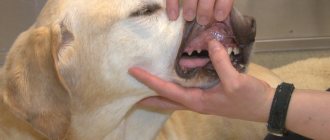How to determine allergies
The main problem lies in the need to prevent seizures in a predisposed dog. To isolate your pet from an allergen, you need to understand what the dog is allergic to. And this is not so easy to do.
As veterinary practice around the world shows, allergic reactions of the atopic type are the most common in dogs. If we translate the term “atopy” from Greek, then the closest synonymous expressions will be “strange, unusual.” Roughly speaking, this can be called any allergic reaction of hereditary origin or generally unknown etiology (idiopathic).
In all these cases, it is extremely important to determine the triggers of the pathology, since without this it is impossible to prescribe effective desensitization. Of course, you can simply pump your dog with antihistamines, but this only gives a temporary effect. Today, the only reliable method for identifying allergens is an allergy test, carried out only in the most equipped veterinary clinics. It helps identify everything from reactions to chicken to side effects of medications.
Features of the dexamethasone test
In veterinary practice, a small dexamethasone test in dogs is carried out according to the following scheme. In the morning, a control blood sample is taken from the four-legged patient and the cortisol content is determined. Then the veterinarian administers an intravenous injection of dexamethasone at a dose of 0.015 (for a small sample) or 0.01 mg/kg (for a large sample) of the animal’s weight.
The next stage of the endocrinological study is blood sampling after 4 and 8 hours. In cats where hyperadrenocorticism is suspected, blood samples are taken at 4, 6 and 8 hours.
Types of allergy tests
There are two main types of allergy tests. Without going into details, in the first case the specialist identifies specific blood serum antibodies produced to a particular type of allergen. There are two standard blood tests that can accurately detect allergens of interest to veterinarians.
- The first is called the RAST (radioallergosorbent) assay.
- The second is ELISA (enzyme-linked immunosorbent assay).
Both methods are very similar to each other, but in practice it often turns out that enzyme-linked immunosorbent assay is much more accurate. True, both methods are quite expensive, and therefore only well-equipped clinics in large cities actively use them. In addition, both methods have certain disadvantages, which we will discuss a little later.
Another type of testing is the so-called skin test . In this case, a small portion of the allergen is injected directly into the animal’s skin, and then the specialist watches how the body reacts to it. As a rule, to speed up the process, a number of small incisions are made on the skin, and a specific allergen is introduced into the thickness of each. This way, within a couple of days (if you’re lucky), you can find out exactly why your pet is developing allergic reactions. We will describe the pros and cons of all methods in more detail below.
Diagnosis of Cushing's disease in dogs
Cushing's disease is very difficult to diagnose. There are several tests that can be done to diagnose or rule out hyperadrenocorticism.
Biochemical blood test: Analysis of liver enzymes. Alkaline phosphatase is usually significantly elevated.
Urine cortisol/creatine ratio: This is a test that can be used to rule out Cushing's disease. The test is best done by collecting urine at home after the dog has been “stress-free” for several days. If the ratio is normal, then it is unlikely that your pet has Cushing's disease; if the ratio is high, then the dog is likely to have hyperadrenocorticism. This test cannot confirm the diagnosis, but can be used to decide whether further diagnosis of Cushing's disease needs to be done.
ACTH stimulation: This is a blood test that can be used to help diagnose Cushing's disease. An initial blood test is taken, then a drug (cosyntropin) is given and, after 1 hour, a repeat blood test is done. If the values are normal, your pet may have Cushing's disease. This test is not perfect and false positive results are possible. False negative results are less likely.
Minor dexamethasone test: another blood test that can be used to diagnose Cushing's disease. An initial blood test is done, then dexamethasone is given, and blood is drawn two more times over the next 8 hours. Sometimes this test can differentiate pituitary hyperadrencoricism from problems in the adrenal glands. Unfortunately, this test is also imperfect and does not always answer all questions.
A major dexamethasone test is performed with a larger dose of dexamethasone administered, and sometimes it is this secondary test that allows the problem to be accurately localized.
An abdominal ultrasound can help diagnose Cushing's disease. The adrenal glands are examined for enlargement. If the cause of the disease is localized in the pituitary gland, then both adrenal glands should be enlarged. If the cause lies in the adrenal gland, only one of them will be enlarged. Many dogs with Cushing's disease also have an enlarged liver that appears brighter than normal on ultrasound. These changes in the liver are not the cause of the disease.
RAST and ELISA tests
To perform either of these two tests, you need to take a blood test from your dog and immediately send it to the laboratory. Since there are only a few clinics that carry out such studies, it would be more advisable to take the dog to any of them so as not to waste time. They test the blood serum's response to a wide range of allergens, including pollen, dust and soils that are common in the region where the particular animal lives (as well as where the dog regularly walks).
Both of these methods are good for identifying more than 90% of all kinds of substances and compounds common in the external environment, but some of them (such as cotton wool and nylon, for example) are less detectable.
A huge disadvantage of RAST and ELISA is their turnaround time - it can take up to several weeks.
And this is not all the problems. No one has ever adapted these techniques for dogs, but they were created by doctors for people. The biochemistry of humans and dogs differs quite significantly! And often all this backfires: an analysis can show the presence of allergies even in a dog that has never suffered from this pathology until old age. Therefore, the old skin test, developed at the beginning of the last century, is more reliable and accurate (in the case of animals, of course).
RAST and ELISA tests, however, are used in special circumstances when skin testing cannot be performed for some reason:
- The dog has dermatitis, dermatosis or another skin disease. In addition, in some breeds (bulldogs) the skin itself is quite sensitive, and therefore such a test is not recommended.
- Please note that for some time before and during the test, taking antihistamines and anti-inflammatory corticosteroids is prohibited. If your dog’s allergies are so severe that he immediately begins to become covered in rashes and crusts, a skin test is also not worth doing.
- This research method is also not very suitable for puppies.
- If your dog regularly participates in exhibitions, areas of clipped and scratched skin are unlikely to make him charming in the eyes of the jury.
- Your veterinarian does not have a complete set of allergens (in these cases, testing will likely be pointless).
- A skin test showed nothing, but the allergy exists and is clearly manifested.
Features of the skin test
Despite all the above circumstances, it is the skin test that is the “gold standard” of veterinary allergists. It is simple, quite informative and relatively cheap. To carry it out, several sections of the animal’s skin are cut and shaved (each approximately 5x5 cm). In the classic case, rows of scratches are then made on the skin (in the form of a grid), and allergens are rubbed into them at intervals of approximately one centimeter. Of course, it is necessary to write down which one and where.
After a few hours or days, they look at the presence/absence of a reaction. If the latter is positive, the pet develops a strong inflammatory reaction in the treated area. The problem is that it is not always very pronounced, and therefore correctly reading the results of a skin test is a real art. Thus, it should only be performed by a veterinary dermatologist with truly extensive experience.
The skin test success rate is believed to be approximately 75%. The effectiveness rate is significantly higher in the spring-summer season, when the intensity and frequency of allergic reactions increases sharply. Please note (although we have already talked about this) that before the test the dog must be “clean” for at least a month, that is, giving him antihistamines and anti-inflammatory corticosteroids is prohibited! Otherwise, there is no hope for the accuracy of the analysis. But still, the exact exposure time should be determined by the veterinarian, based on the characteristics of the allergy and the condition of the animal.
Useful video
Watch this video about diagnosing Cushing's syndrome by performing a small dexamethasone test:
Similar articles
- Cushing's syndrome in dogs: causes, symptoms, tests...
The dexamethasone test is based on the difference in the level of cortisol in the blood before and after the introduction of an artificial hormone. This method is not suitable for identifying Cushing's syndrome caused by long-term use of glucocorticoids. In this case, the veterinarian uses a stimulating... Read more - Addison's disease in dogs: causes, symptoms, treatment
Often, Addison's disease in dogs can go undetected because it has many unclear symptoms. .serp-item__passage{color:#888}... Symptoms of Addison's disease in dogs. The insidiousness of the disease lies in the fact that due to unclear symptoms, the owner does not immediately pay attention to the dog’s health problems. Read more
- Eye injury in a dog: causes, treatment, dog after...
For information on the treatment of eye injuries in dogs, watch this video: Dog after injury. Mechanical or chemical damage to the eyes of pets requires certain care after initial treatment or surgical... Read more
- Traumatic brain injury in a dog: how to treat it...
Due to injuries and bruises, a dog may experience a traumatic brain injury. Head injury is dangerous because it can... Symptoms in a dog. Symptoms of traumatic brain injury are determined by the degree of damage to brain tissue and the location of structural changes. Read more
- Spinal fracture in a dog: symptoms, treatment...
A spinal fracture in a dog can occur for various reasons. Symptoms may include urinary incontinence and inability to stand up. First aid is especially important for a compression fracture. Read more
General features of allergy tests
All the methods we describe have several common features:
- Tests should be carried out in the spring-summer period , when the concentration of potential allergens is maximum and the dog’s body’s response to them is the most vivid and clearly visible.
- specific desensitization should be immediately prescribed . Only and only after this can animals be given antihistamines. As a rule, the duration of the therapeutic course for desensitization ranges from several weeks to several months. This is how long it takes for a dog’s body to become resistant to certain antigens.
- Before carrying out any test, all other causes of rash , redness of the skin, etc. It is necessary to exclude exposure to ectoparasites (such as fleas, ticks and lice), fungal or bacterial infections of the skin. Finally, hyperthyroidism produces similar symptoms. To exclude it, it is necessary to conduct a complete biochemical blood test.
- We strongly recommend putting your pet on a hypoallergenic diet for 12 days. Firstly, this will allow us to more accurately identify the specific cause. Secondly, this can reveal the presence of a food allergy to food and/or intolerance to specific food components. This will save a lot of time and reduce the cost of the diagnostic process itself.
We would like to warn all owners about one important circumstance. Any allergy treatment (and not just suppressing its symptoms with antihistamines) is a long-term and very expensive task. Moreover, all the above tests without specific treatment involving desensitization are a waste of time and money.
Interpretation of results in cats and dogs
A veterinarian can make the correct diagnosis and carry out differential diagnostics based on the results of an endocrinological test. Interpretation of the small dexamethasone test in dogs is based on identifying changes in serum cortisol concentrations 4 and 8 hours after hormone injection.
So, if after 8 hours the cortisol level fluctuates between 28 and 40 nmol/l, then the veterinarian considers this result as doubtful. If the hormone concentration reaches 40 nmol/l after 8 hours, this indicates the development of Cushing's syndrome in the animal.
Example of analysis result
In pituitary-dependent hyperadrenocorticism, 4 hours after dexamethasone administration, the cortisol level is below 40 nmol/l. After 8 hours, the hormone concentration is 50% of the initial cortisol level in the blood (before the administration of dexamethasone).
We recommend reading about why a biochemical blood test is performed on a dog. From the article you will learn about how to prepare your pet for testing, what the biochemical blood test indicators will indicate, and deciphering the results.
And here is more information about the basic tests for hormones in dogs.
One of the reliable diagnostic methods for suspected development of an endocrinological disease in a four-legged pet is a dexamethasone test. The procedure allows not only to detect the level of cortisol in the blood, but also to carry out differential diagnosis.
In veterinary practice, small and large dexamethasone tests are used, which differ in the dose of the administered drug. The interpretation of the results is influenced by stress, as well as the use of a number of medications, which should be taken into account during the procedure.
In what cases is an allergy test necessary?
An allergy test is mandatory for all dogs that suffer from constant allergic reactions for at least four months a year, as well as for animals whose bodies no longer respond to conventional antihistamines. Please note that in many cases the animal's condition can be improved by including a sufficient amount of fatty acids in its diet. Alas, in practice there are many cases when owners of dogs who suffer from severe allergic reactions limit themselves to only occasional administration of antihistamines and do not take their pets to the veterinarian.
Please note that delaying a visit to the clinic is fraught with many dangerous consequences. In particular, such dogs may develop incurable autoimmune diseases that are of allergic origin.
So you shouldn’t put off going to a specialist for a long time: this is fraught. In addition, always choose those veterinarians who offer not just to suppress the signs of allergies, but actually treat your pet.
Allergy to dogs
For a person allergic to dogs, life is not easy in a country where these animals are loved. In Ukraine, approximately 30% of families keep dogs. The fur of these animals is everywhere, even in places where a dog’s paw has never gone. According to the National Institutes of Health, every home in the United States contains pet hair.
So how do you live with an allergy to man's best friend? Below are the causes and treatment of dog allergies , as well as tips on how to avoid them.
Dog Allergy Symptoms
Symptoms of dog allergies are similar to those of any other nasal allergy and include:
- Cough and wheezing
- Red, irritated eyes
- Runny and stuffy nose
- Sneeze
Some people with dog allergies also experience a skin reaction. For example, the skin becomes inflamed at the site of saliva contact. People with more severe allergies may develop a rash on their face or chest. Those with asthma, as well as those with dog allergies, may experience particularly severe symptoms.
Causes of allergies to dogs
You've probably heard that some dog breeds cause allergy symptoms while others don't, or that short-haired dogs are safe while shedding breeds are not. But experts believe that this is not the case. In fact, dogs of even the same breed can produce different levels of allergens. The problem is not the fur, the allergy is usually caused by dead skin cells, as well as saliva and urine. Therefore, it is not a matter of how long or short the coat is; every dog carries the potential for an allergic reaction.
You may be wondering why a dog's fur produces this effect. People with allergies have very sensitive immune systems. In this case, the body reacts to harmful substances, like viruses or bacteria. Sneezing and eye irritation are just side effects of the body's attempts to destroy or get rid of the allergen.
Dog allergy test
To determine whether you have a dog allergy, your doctor may suggest a skin test or blood test called a radioallergosorbent test. Even if you are sure that you have an allergy, the analysis will help to make sure of this. Sometimes people make mistakes and it turns out that they are allergic to pollen or mold that dogs bring in from the street.
Although an allergy test is effective, it is not always conclusive. This means that if you have a dog, your doctor may suggest living without it and observing the symptoms. This may take some time to give an objective assessment; it will typically take a month for the level of hair accumulation to drop to the level seen in a dog-free home.
Dog allergy treatment
Standard medications that are used in the treatment of allergies can also be used in the treatment of animal allergies. The doctor may suggest:
- Antihistamines, which block the action of chemicals that cause symptoms. They can be over-the-counter, like Claritin or Benadryl, or prescription, like Alegra or Cirtec. Some antihistamines come in spray form, such as Astelin.
- Decongestants that reduce swelling and prevent mucus buildup include Sudafed, which is available over the counter, and Allgra-D, which is available by prescription.
- Other medications that treat allergy or asthma symptoms in different ways. Prescription steroids such as Flonase or Nasonex sprays are traditionally used to treat allergies.
A course of allergy injections does not solve the problem of people with allergies to dogs . They are not effective for everyone, and the full course of treatment can take years. But in some cases they can really help. Discuss their advantages and disadvantages with your doctor.
Next »











